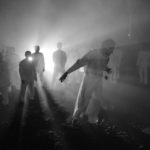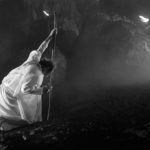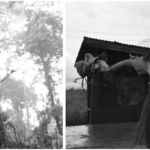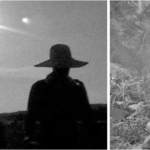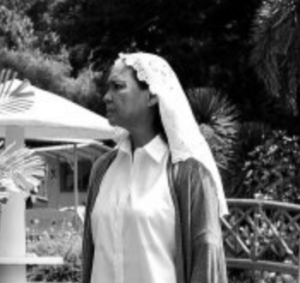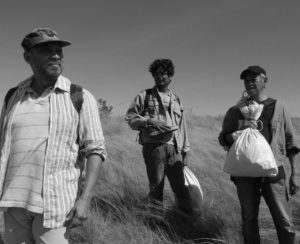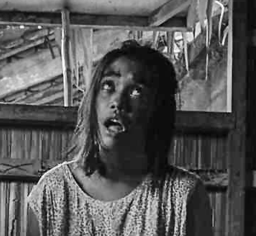Lav Diaz
Philippines Year Zero
E se io muoio da partigiano,
tu mi devi seppellir…
– Bella ciao
Since his directorial debut in the late 1990s, Filipino filmmaker Lav Diaz (b. 1958) has been trying to chronicle the history of his country as marked by four major “cataclysms”: Spanish colonization (1521-1898), American rule (1898-1946), Japanese occupation (1942-1945) and Ferdinand Marcos’s fascist dictatorship (1972-1986)[11] [11] For more information about Diaz’s biography, filmography and artistic credo, see Michael Guarneri, “Long Story Long: An Introduction to Lav Diaz’s Free Cinema” (2016). Moreover, the edited collection Lying Down In A World Of Tempest – Lav Diaz (2015) can be downloaded for free. .
In September 2016, I met Lav Diaz and his team of friends and family at the 73rd Venice International Film Festival, where they were presenting 226-minute vigilante movie The Woman Who Left (2016), a bleak tale of reclusión perpetua, rape and revenge vaguely inspired by Leo Tolstoy’s short story God Sees the Truth, but Waits (1872)[22] [22] Here is an English translation of God Sees the Truth, but Waits. . In the interview that follows, however, the discussion revolves around Diaz’s previous effort, A Lullaby to the Sorrowful Mystery (2016), a 8-hour “kolossal” that – by mixing historical records, Malay folklore and scenes from José Rizal’s political fiction novel El filibusterismo (1891) – transports us in the late-19th-century Philippines, where various groups of Filipino nationalists took up arms to fight the Spanish colonizers and obtain independence. According to Diaz, it is only by learning about these revolutionary pioneers and reconnecting to their spirit that the Filipino people can get rid of “the feudal lords of yesterday and today”, and eventually achieve freedom.

Débordements : The idea of making a period film about the Philippine Revolution against Spain (1896-1898) hovered in your mind for more than a decade before you actually shot and edited A Lullaby to the Sorrowful Mystery between late 2014 and early 2016…
Lav Diaz : Yeah, in 1998 the Government of the Philippines announced a contest for screenplays as part of the National Centennial, the celebration for the 100 year anniversary of our independence from Spain. Basically the Goverment was looking for film projects about the heroes of our country, so I wrote a script about the death of Andrés Bonifacio, the father of our revolution against the Spanish colonizers. My script was based on a very very obscure diary note written by Gregoria de Jésus, Andrés Bonifacio’s wife. In her diary, she described how she had searched for the missing body of her husband for 30 days, wandering around in the rainforest where Andrés Bonifacio and his brother Procopio were murdered by a rival group of revolutionaries led by Emilio Aguinaldo. In 1999 I finally completed my screenplay and I submitted it to the Centennial Commission. I was one of the ten winners and I was awarded 5 million pesos to make the film. Being a novice director at that time, I was very excited and I immediately started doing location hunt and casting. But suddenly the Government canceled my contract. In the end, the Government produced just one film out of ten, a movie in which Emilio Aguinaldo – the murderer of Andrés Bonifacio – was the real hero of our country. You know, it clearly was a political decision: I did a little research and I found out that the grandson of Emilio Aguinaldo was in the Centennial Commission. Aguinaldo’s grandson was a financial officer during the Martial Law years (1972-1981), the most brutal period of Ferdinand Marcos’s dictatorship in the Philippines, and in the late 1990s he still was a very very rich and powerful politican. So my funding was canceled because my film was going to speak against Emilio Aguinaldo, and I couldn’t shoot anything.
I tried to shoot my film about Andrés Bonifacio again in 2003, when I came back to the Philippines after a long stay in the United States, but I was unable to start the shoot because of lack of funds. Also, at that time, I couldn’t find the right actors and the right locations. The latter were very important to me, because I was looking for the rainforest of the 1890s, a place where the so-called modernization hasn’t arrived yet. It’s hard to find such a place nowadays in our country. So I just kept on researching the history of our revolution against Spain and endlessly revising the script… The script of what today is Lullaby had so many incarnations and iterations throughout the years…
In 2008 I met a Polish-Ukrainian friend who told me that he would produce any film I wanted. He gave me a lot of money, about 25.000 USD, but since my Bonifacio project wasn’t quite ready yet, I shot another film for that budget. The original title of my Bonifacio project was The Great Desaparecido. This Polish-Ukrainian friend and I were planning to shoot The Great Desaparecido on 35 mm in the rainforest: we planned and planned and planned, until the Ukrainian War broke out and all our plans dissolved. Out of prostration, I didn’t want to make this film anymore, so I focused on other stuff for a while. However, one day, Filipino producer Bianca Balbuena approached me and asked me if I had any project that she could work on. You know, looking for funds, etc. So I gave her my screenplay about Gregoria de Jésus searching for the missing body of her husband, our national hero Andrés Bonifacio. Bianca liked the story and started looking for money… in Europe, of course [Laughs]. We contacted a lot of European institutions, but they all rejected the project eventually. So we went back to the Philippines and luckily we found Paul Soriano, a young filmmaker who has a lot of money. Paul liked the screenplay very much and he gave us 8 million pesos, which is roughly 150.000 USD, a colossal amount of money for me. With a 150.000 USD budget, Lullaby is indeed my kolossal : just look at the big crew in the credits! Paul offered us even more money, but I said: “8 million pesos is more than enough, man!”.
Then, as soon as the money came in, all the pieces fell into place. Actor John Lloyd Cruz had been telling me throughout the years that he wanted to work with me – he is one of the biggest TV and movie stars in our country. The same goes for Piolo Pascual, who is also a TV and movie star. So I sent them the script: do you want to play Isagani? Do you want to play Simoun? They accepted, they were enthusiastic. But there was a problem: both John Lloyd and Piolo are employed by the biggest network in our country, ABS-CBN, and they had binding, exclusive contracts tying them to the studio. One of the top executives of the network, Charo Santos, kindly helped us with the negotiations, and in the end John Lloyd and Piolo were able to take part in our film. So that’s the long history of the making of Lullaby [Laughs]. At some point I really wanted to give up on this Bonifacio project. I told myself: “Maybe I can just simplify the premise of the story, focus on the search for the missing body…”. That’s why I did Prologue to The Great Desaparecido (2013)… A simplified, very short version of the story, to help raise funds…
D. : Yes, I remember that there was a crowdfunding campaign connected to Prologue to The Great Desaparecido. Did the crowdfunding work?
L.D. : No, it didn’t work at all. But we were able to find Paul Soriano, who helped us so generously, and everything went fine in the end.

D. : Contrary to your usual modus operandi, you hired a cinematographer to shoot Lullaby…
L.D. : Yeah, I hired Larry Manda. We also did Norte, the End of History (2013) together, recently. You know, Larry and I were classmates at the Film School in Manila, in the 1980s. He eventually became a director of photography and he did my very first shoot, when I was working for Good Harvest [a branch of Regal Films, a huge entertainment corporation in the Philippines]. The film was called Burger Boys (1999), it was my debut as a director. Anyway, Larry and I are buddies, we are best friends. I like to work with Larry because, contrary to me, he is a very serious guy… [Laughs] He studies the script night and day. He is a very studious guy, very scrupulous, very clinical. Everytime he has a job as cinematographer, he does a lot of technical tests: lenses, film stock, digital cameras, everything. Actually, he was very helpful when I shifted from film to digital in the early 2000s. He helped me a lot during the long process of making Evolution of a Filipino Family (2005)… Larry is a great guy, a great friend, a great cinematographer.
D. : Why did you need a cinematographer for Lullaby ?
L.D. : Lullaby was a huge production for my standards. Everytime it is huge, like in Norte, the End of History, I want to… You see, one of my principles in filmmaking is this: if I receive money for a project, I want to employ my friends, so that I can help them financially while they help me making the film. And of course it is also an issue of trust. I must work with people I trust, and I trust my friends: Larry, Hazel [Orencio], Kints [Kristine Kintana]… They know my methodology, they know my mentality, they know my perspective on cinema… Having friends around you makes everything easier, including filmmaking.
D. : In Lullaby, you have one of your characters summarising your artistic credo in one sentence: “Art expresses only one thing: freedom”…
L.D. : One of the greatest debacles in my culture, in my country, is ignorance. Filipino culture is like that, you know: we tend to neglect the better parts, the more beautiful parts of our nature, of our struggle as a people. And since we suffer from this malady, my idea is that aesthetics – the arts – must play a greater role in our culture, and educate people about self-awareness, about self-respect, about sovereignty, about freedom. The years of Spanish colonization, the years of American domination, the years of Japanese occupation, the years of Martial Law… For centuries we Filipinos have been imposed on: politically, economically, culturally… It was very very violent, and we were – and we are – kept really really ignorant. So that’s the point of aethetics to me: art is all about freedom, about being autonomous and making your own decisions, about being free from the clutches of feudalism, imperialism, hegemonism. Art is all about liberating yourself from those who want to control your existence, telling you what to do, what to think.
D. : More specifically, how would you situate Lullaby in your struggle to reach artistic freedom and stay away from the “business and bullshit” of the Filipino film industry? I am asking because some of the actors involved in Lullaby and in your most recent film The Woman Who Left are big names in the Philippine studio system, in the entertainment industry…
L.D. : I told John Lloyd and Piolo that I work to destroy this classical divide – the indie and the mainstream. There should be no divide: cinema is one, cinema is free, independent. Cinema is art. The divides are created by the feudalism of the market. So I told John Lloyd and Piolo: “Come and work with us, freely!”. I told John Lloyd: “You are one of the most popular icons in our country, work with us in freedom. Work with us for freedom. Don’t think about your public persona. Just do your part as an artist, for your country, for your people. Work with us on issues of aesthetics, on issues of culture!”. He really understood what I meant, he is a bright young man, very talented, he will help our country so much, I am sure. So John Lloyd and Piolo came on board, and they were very attuned to this idea of doing a collaboration, of contributing to the greater struggle of the Filipino people.
And after all, you know, there are no movie stars in the depths of the forest, in the place where we shot Lullaby. There is no class privilege in the rainforest ! So by taking John Lloyd and Piolo there, I took them out of their “comfort zone”. Do you know how they usually work? They have a lot of production assistants, they have air conditioning, beautiful hotel rooms, trailer trucks, and people attend to them as if they are gods… But in my shoot they are just part of it. We sleep in the mud, they sleep in the mud; we walk for so many kilometers in the forest, they walk with us. And, slowly, they become part of it. The experience changed them, I think. John Lloyd is also in my new movie The Woman Who Left, a film made with a crew of seven to ten people, contrary to the huge crew of Lullaby. John Lloyd went with us on Mindoro Island, where most of The Woman Who Left is set. He came together with another big star and corporate executive, Charo Santos, who plays the title character. And they are cool, we are cool with each other, everything is fine, we work well, it’s almost always take one. I think it was a very very enlightening experience for them. I think that what I wanted to do with both Lullaby and The Woman Who Left was showing John Lloyd, Piolo and Charo that there is something else besides what they have been doing for most of their career. I wanted to broaden their horizons, and tell them that they can push Filipino cinema forward by using their popularity. I had a discussion with John Lloyd this morning. I told him: “Man, you can use your persona to push greater causes in our country, like unionizing the film industry, so you can improve the lives of so many Filipino workers. You can say things about the cultural development in the country, it would be so important!”. So John Lloyd, Piolo and Charo are now working very altruistically. Piolo refused to get his salary for Lullaby, he gave it to the other workers. So, little by little, the vanity is disappearing. We have a lot of superstar actors in the country – very narcissistic, vain, self-absorbed, self-centered… It’s all about them, all about the heart-throb persona, living like rock stars, being popular. Now they understand their role a bit more, and they understand more about the role of cinema as a tool to change the condition of our people for the better, to give our people knowledge, a direction, an orientation, to say what happened and what’s happening in our country.
D. : Do you have the feeling that you can really start challenging the Philippine studio system now, instead of just rejecting it through your “non-commercial” temporal strategies and aesthetics?
L.D. : I don’t know, honestly. It’s a work in progress, you have to work on it every day. You have to present to the public the importance of cultural works. In the last 100 years our people were imposed on by Hollywood and the Philippine entertainment industry, so we have to be really patient about this: there is no easy fix, there is no miraculous solution to make up for a hundred years of lies and escapism. We have to work on it. Slowly. And it’s good that big actors like John Lloyd, Piolo and Charo are joining us, to play a role in educating the masses. It’s good that they are helping and collaborating with us. It’s important.
D. : When talking about cinema, one cannot avoid discussing two things: money and death. So far, we have talked mostly about money. Let’s talk about death now. I think that the starting point could be the essay Ontology of the Photographic Image (1945) by your all-time favourite film critic André Bazin. In Bazin’s essay, cinema – which is based on photography – is said to have its roots in funerary rituals, the cult of the dead. Is Lullaby a funeral?
L.D. : Yeah, yeah, it’s a funeral. But it’s also a film about rebirth. Just like funerals, Lullaby is for both the living and the dead. You know, I like to reason and build my works on a dialectical movement, a relation between opposites: death and rebirth, devastation and reconstruction. I work on these big dualities in the so-called existence of Man. There’s always devastation and regeneration. That’s Lullaby, yeah.
D. : And talking about the living and the dead, the tragedy around which Lullaby is built is that Gregoria de Jésus cannot find her husband’s corpse, she cannot give Andrés Bonifacio a proper burial… As you have already shown in Melancholia (2008), your masterpiece about desaparecidos, corpses are fundamental to start the mourning process and slowly overcome grief. Without a corpse, the living cannot achieve closure, they cannot move on, they are…
L.D. : Trapped in an abyss of endless, fathomless sorrow. Yeah, that’s Melancholia… and that’s Lullaby, too. Do you know the feeling, when you hear a lullaby and you start slumbering? It is so beautiful to be slumbered by a great lullaby, but what we need more in life are revolutions, upheavals. We need reconstruction, education. So we need to wake up, stay awake, vigilant, to build a better future. We don’t have to let go, enchanted by the spell of melancholia, this wonderful lullaby. It’s a dialectical movement, again: we must think of the future but, at the same time, we need to confront and analyze the past, to be able to have a direction and do upheavals, revolutions. For me, Lullaby really is an important work in my filmography, in my struggle as a cultural worker in my country and in South-East Asia. It deals with this abyss of not finding your soul. It represents our search for truth in everything that we do, in our so-called existence. That’s the importance of Lullaby to me.

D. : Certain corpses are hidden: José Rizal’s body was hidden by the Spaniards after he was executed (luckily the Rizal family later found the body). Andrés and Procopio Bonifacio’s corpses were hidden by their murderers and they were never found, just like the bodies of all the desaparecidos, in the Philippines as everywhere else. On the contrary, other corpses are publicly exhibited and preserved for future memory. Let’s talk about the corpse as a political instrument.
L.D. : The more important you are the more you’ll be pushed out or hidden: this is the case of Rizal and the Bonifacio brothers. They were made invisible by their enemies – the Spaniards and Emilio Aguinaldo, respectively – because they were so important. I guess it has something to do with psychoanalysis, it sounds very Freudian to me, when I think about it… Something very important that is put away, out of sight, out of reach, out of consciousness, like a memory that is repressed.
But there’s also another strategy, the strategy for making common people disappear. Again, you work on the visual level, on the “gut-level” emotions of people. For every hero that disappears there are thousands of normal people who are killed. There can be victims any day, as during [Marcos’s] Martial Law, and they are made into numbers, they are just statistics. It is happening again in the country these days. You know, the new President of the Philippines, Rodrigo Duterte, is a power-hungry politician who uses demagogy to capture the sympathy of the common people, playing upon their ignorance and “gut-level” emotions. Duterte is neither left or right. He ran for President as an independent candidate. He presented himself as a strong man, he took money from all sides for his campaign, including the Marcos clan. He also took money from our former President [Gloria Macapagal Arroyo], who was in jail for plunder at that time and, after Duterte won the elections, was acquitted and released. This is to say that Duterte is a demagogue. He is interested in power, in ruling to achieve his twisted causes, not to help the people. And in fact, now that he is President, he is waging war against the Filipino people. It’s this drug war campaign he launched to “cleanse” the country, basically giving impunity to those who kill alleged drug addicts or pushers. What about these dead people? Who are they? Behind the numbers, the statistics, there are common people, the poor… 3000 dead and Duterte has been in charge for only two months! The people who voted for this President are the same who are being massacred, and they don’t actually realize it. That’s the fascinating thing about demagogy. The people idolize the demagogue who is killing them. It’s a crazy, crazy psychoanalytic thing, when you don’t realize you are the victim! It’s blind faith, it’s a very very dangerous kind of situation.
D. : And as we speak, Duterte is planning to give Filipino dictator and kleptocrat Ferdinand Marcos military honors and burial at Libingan ng mga Bayani, the Cemetery for Filipino National Heroes…
L.D. : Yes, it’s a very very big issue in the country now. They planned to bury Marcos in the Cemetery for National Heroes on September 11th 2016, but then there were a lot of protests and a lot of groups filed motions and complaints, so the Supreme Court twice postponed the burial. Now the ceremony is going to be held on October 20th 2016. We have obtained a reprieve and we are trying to force the Marcos loyalists not to bury that criminal in the Cemetery for National Heroes. My stand is: I don’t want Marcos there. But then the President of the Republic is allowing it… Duterte is a friend of the Marcos family, and Marcos’s son was close to becoming his Vice-President. I don’t know what’s going to happen. The Supreme Court has postponed the burial for now, but what would happen to our country if the burial does happen someday? It’s gonna be crazy, it’s gonna be chaos! A lot of people will be very very happy, a lot of people will be very very angry and mad. Maybe there’s going to be a civil war, who knows? This divide among our people is due to the ignorance I mentioned earlier, the lack of confrontation with our past in relation to the Martial Law era, Marcos’s brutal dictatorship.
D. : There is another film that, like Lullaby, reenacts the Philippine Revolution against Spain: it is Filipino mainstream film El Presidente (2012) by Mark Meily. You pointed this film out to me two years ago in Locarno as something your Lullaby project wasn’t going to be. Can you expand on the differences between your film and El Presidente ?
L.D. : El Presidente is based on Emilio Aguinaldo’s autobiography. It is based on the autobiography of the murderer of Andrés Bonifacio, so it’s full of lies, it is a very revisionist work. In El Presidente they made Aguinaldo a superhero, like he’s doing the right thing when he kills Andrés and Procopio Bonifacio, and other generals and lieutenants during our revolution.
D. : So who owns the truth, the one who speaks louder?
L.D. : Yeah, it’s the same everywhere. It’s all about publicity, about broadcasts in the media. If you control the media, you can transform the apocryphal into truth. The lies can become the truth if you control the televisions, the radio stations, the newspapers, the Internet. It’s all about revisionism, it’s very dangerous. El Presidente is a work of revisionism, and now they are going to bury Marcos in the Cemetery of Filipino National Heroes… And a lot of people are into it, they really consider Marcos a great man who did a lot for our country. You wouldn’t believe how many people think that Marcos is a hero. They don’t realize, or they just forgot, that this guy plundered our National Treasury for about 10 billion dollars. He emptied the banks, man! He murdered and tortured a lot of people, he put the country on the brink of oblivion during his reign. They just forgot about it. This is the result of revisionism. Come to the Philippines, take a cab and the taxi driver will start telling you all the myths about Marcos. He will tell you that if we have highways in the Philippines we must thank our great man Marcos. This is absolutely false: various politicians before and after Marcos ordered the construction of highways around the country. But the myth was put around by Marcos during Martial Law, and his clan kept on insisting on it, bombarding people through the media, so it eventually became the truth.
D. : Are you a guardian, a watchdog of history?
L.D. : I am trying hard to be. I am part of the struggle to protect our rights and our dignity as a people. It is part of my responsibility as a filmmaker. I am just a small guy, a small part of this struggle, I don’t know what will happen, I don’t know if I am helping or what… But one thing I do is arguing with taxi drivers. I always try to confront them, to present them my point of view on Marcos, on Duterte, on our history. I never succeed in changing their minds, of course: their faith – it is really faith, as in religion – is very strong. It is blind faith. They just won’t accept other points of view. It’s fundamentalism. There can really be no dialogue.
D. : In Lullaby it is said that art will “commit to memory their [the Spanish colonizers’] crimes” and “weep and mourn for the country”. As you said, we must remember the past and learn from what is before, so that we won’t make the same mistakes over and over again. At the same time, the past is a burden we should free ourselves of, and get it over with, as in the mourning process. The character of Gregoria de Jésus is emblematic of this dialectical tension, this difficult balance or synthesis to be reached between remembering and forgetting. Tell me about Gregoria: beaten, abused, raped, traumatized, wandering around, lost and numb, she is, as all the women in your films, a metaphor for the whole country…
L.D. : Yeah, Gregoria looking for Andrés Bonifacio’s body is the motherland looking for its soul. The neverending search. It’s a metaphor for that. Lullaby is about a country searching for its soul. In my new film The Woman Who Left, Charo Santos plays a mother looking for her lost son. It’s the same thing. The Woman Who Left is set in 1997: one hundred years after the events portrayed in Lullaby, Gregoria’s search, our search, is still going on…
Searching, researching: these are the keys. You have to confront the past, to be able to cure your sorrows and move on. The thing is we Filipinos avoid this confrontation. It is a cultural avoidance. We are not dialectic about the past. We don’t examine the past: this is our problem. We need to cleanse ourselves to be able to pursue the greater truth and achieve freedom. But how can we pursue the greater truth and be free, if we deny both the lies and the truths of the past? So now the past is coming back to oppress us. The current President of the Philippines is a fan of Marcos. He believes in Marcos, he believes in all the lies of Marcos, he is allowing this criminal to be buried in the Cemetery for National Heroes. He wants to be another Marcos, he is another Marcos – a demagogue.
D. : “The lost will circle back and return”, “History repeats itself”, as your characters say in Lullaby…
L.D. : Exactly ! It is a vicious circle now. We thought that we were moving forward, making progress, but we are going backwards again. It’s just two months and we have 3000 deaths already. Two months of Duterte’s presidency and Marcos is back. The spectre of Marcos is back. The son almost became Vice-President, I told you. It’s terrible. It’s like: what do we have now? Nothing. What have we achieved after all these years of struggle? Nothing. We have to fight back again, we are back to zero. We have a demagogue for a President now, it is Marcos again. That means we are back into the barbarism of the feudal system. All our democratic institutions are being smacked. And we are not doing anything, we seem to be incapable of fighting back. There’s a reign of fear in the country right now. You cannot talk, because you don’t know who’s in front of you: maybe he or she is a Duterte supporter. If you commit a mistake, you become another statistics in the death count… 3001 deaths in 2 months of presidency. Somebody will just accuse you of being a pusher, of being a drug addict, and you are gone. Like that [makes the gesture of pointing a gun and shooting]. It’s like the Martial Law years again, it’s like the Japanese occupation again, it’s like the American period again, it’s like the Spanish period again. We have gone back to the period of barbarism: suspicions, paranoia, lurking fear, violence.

D. : One of the lessons that we can learn from Lullaby is that the revolution is fought not only on the battlefields, but also in the imagination of Man. In fact, in your film, we have the mythical giant Bernardo Carpio, enchained like a Filipino Prometheus; we have the half-human/half-horse spirits of the forest called encantos, and various religious cults, all rooting for or scheming against the Spanish colonizers. Let’s talk about the dialectical tension between myth and truth: myths are not real, but they can express fundamental truths about Man’s existence (Bernardo Carpio, for example, stands for the desire for freedom of oppressed people). Myths are not bad in themselves…
L.D. : There’s a distinction to make, here. There are myths such as the folktales of our tradition, I always incorporate them in my films, because they are part of the Malay culture, my culture. But beyond the folktales, there’s cultural myth-making, by which I mean when power-hungry demagogues create myths about their personas. These people – Marcos, Duterte and so on – are political masters, you know. Marcos created hundreds of myths about himself, and propagated them through the media he controlled. We Filipinos really believe in myths. It is our culture, it is our mindset, it is the way we are. And when a culture like ours, a culture that is prone to believing in folktales and parables, lacks education, cultural myth-making rampages and lies can be fed to the people all too easily. So these demagogues, these political masters, create myths about their persona to manipulate the people. It’s a very very clinical operation.
A classic example is Marcos. He created lies about himself, people believed him and he became President. He even used cinema. In the 1960s, he produced a film called Iginuhit ng Tadhana, which means “Written by Fate”. In the film, Marcos had himself portrayed as a hero: he annihilated a battalion of Japanese soldiers during World War II, the Americans gave him a lot of war medals, etc. The film came out [in 1965] and he became a hero in the minds of the people, and not surprisingly he was elected President of the Philippines shortly after. Iginuhit ng Tadhana is myth-making to the core. And it happened again with Duterte. Duterte studied what Marcos did and copied it. This is the practice of demagogy. You work on the ignorance of the people, you keep people ignorant, you create myths around your persona. And that’s it, the job is done. Duterte created this myth about himself: he said that the city from which he came from, the city in which he served as a mayor for a long long time, was the safest city in the country. He pushed this issue through the media: “Davao City is the safest city in the country thanks to Rodrigo Duterte!”. It was myth-making to the core: Davao City is not the safest city in the Philippines. But he insisted and insisted, he presented himself as the strong man the country needed, he became a hero to the masses and when he ran for President, he won. Now he boasts a 91% popularity rate in the country, the highest ever in our history.
D. : Do you think it is possible to use myths in a positive way?
L.D. : Yes, yes, but there’s always the risk that somebody will use myths for personal benefit, for propaganda. Myths are dangerous when they become propaganda. They can be used in a very positive way, of course: to propagate culture, to investigate and be dialectical about history, to create real narratives that talk about your civilization, the beauty of your people, the beauty of your land, the beauty of your existence. These are all very positive ways of using myth-making. But if you use myths in a very very narcissistic, fraudulent way, they become propaganda and it is very very dangerous. And people like Marcos and Duterte use cultural myth-making this way: demagogues know the trick and they play on the ignorance of the people. And they keep people ignorant to better feed them lies. Again, it’s a vicious circle.
D. : In Lullaby, you have an encanto of the forest, a mythical creature, state the ultimate truth about myths, i.e. that “a mythical creature cannot save you”…
L.D. : Yeah, the encanto is saying: “We are just myths in your mind, man! Why do you believe us?”. I hope that many Filipinos can watch Lullaby, but no, they didn’t even promote it in the country after Berlinale. So once I finish this residence at Harvard that I will do in the next few months, I’ll just tour the film myself on campuses all over the Philippines. It is all about re-educating the masses. I am going to use Lullaby to do it. It is frustrating, really frustrating for me. Because a lot of people didn’t see the film in our country.
D. : I don’t know if it’s your case, but many colleagues of yours have been telling me that they need more money to promote the film than to make it…
L.D. : That’s why, that’s why. You are right there. I keep making movies, but then there’s no money to promote them, there’s no chance to really propagate my work. It’s a big failure for me as a filmmaker. I am powerless there. I really don’t know how to do it. So now I am thinking of just touring the works myself, you know: campuses, institutions, galleries and so on. I’ll finish the residence at Harvard and I will do that, man. It is so frustrating now, I have to do something. I feel like a fraud. I am a small guy, but I feel like a fraud all the same, you know. I feel like everything I do ultimately goes to waste. Because I don’t really reach my people. Not just my work, but the work of thousands of activists and cultural workers in the country is going to waste now. It’s hard for me to swallow it: we are back to the dark ages. We kept on talking about it last night. We look at each other in the eyes, and we are like: “What happened to our country? In two months we are back to the age of barbarism!”. We are like: “Wow, we have a psycho for a President!”… [Nearby children start running and shouting, followed by their mother shouting at them]
D. : Just a second, let’s wait for the children to stop…
L.D. : Let the kids shout, man, they are the future… [Laughs]
D. : When he says that “a mythical creature cannot save you”, the encanto is talking with dying Karyo, a guy who couldn’t take part in the revolution against Spain because of tuberculosis. Since you had a lung disease when you were a young man, I was wondering if there was any autobiographical element in the Karyo character.
L.D. : Well, first of all there’s history. In that period, the late 19th century, so many Filipinos were dying of TB. There was an epidemic in our country: entire villages were being wiped out at that time. Hundreds of thousands of people. And the people with TB and flu were not allowed to join the revolution. That’s a crazy idea. Why? Just give these guys some guns, they are going to die anyway. All the people with flu and TB were rejected, why? So there’s this historical aspect, this question I kept asking myself. But then, yeah, Karyo is a character who feels this guilt, the guilt of not being able to help the revolution, to be part of the physical struggle against the enemy. Although his mindset is all about freedom, he cannot fight and he suffers, because he cannot take part in the greater struggle. I have that very same guilt now: I am helpless, I feel like a paralytic now.
Among us Filipinos, there’s paralysis now, we don’t know what to do. We discussed it all night yesterday: paralysis is our malady. I contracted polio during my childhood and I was actually paralyzed twice, so I know the feeling, the physicality of it. What we have now is more subtle, more psychological: we talk and talk and talk endlessly about the things happening in our country, but we couldn’t and we cannot do anything about it. Here in Venice we talk openly, but in Manila most of the times we are behind closed doors. We don’t feel free in our city, because you don’t know who is listening. As I told you, I argue a lot with taxi drivers about politics and my friends are getting scared lately. My friends tell me: “Lav, they are going to hit you, don’t do that again, please!”. I had a very heated argument with a taxi driver recently, and he told me: “I will remember your face, I know where you live, be careful!”.
D. : Meaning that he could report you on fake drug charges and get you killed?
L.D. : You know how threats work: the vaguer, the scarier. So I don’t know what he meant exactly. I know that he meant to play on this climate of fear created by the President who wants to “cleanse” the Philippines.

D. : The novels, essays and poems by José Rizal inspired the Philippine Revolution against the Spanish colonizers at the end of the 19th century. Books can start revolutions, we have seen it happening. Do you have similar hopes for cinema, and for your films in particular? I am asking because you were born on the same day Rizal was executed, December 30th.
L.D. : It is a coincidence, man! [Laughs] But I think it runs in our family, because my elder brother was born on the very same day Andrés Bonifacio was born, November 30th. That’s why my parents decided to call him Bonifacio Diaz. Bonifacio Diaz, that was his name. And, strangely, my brother Bonifacio died at the age of two: he bled to death after a doctor injected him something against fever. He bled to death and this is very Andrés Bonifacio, because the father of our revolution was sick and bleeding to death when his rivals were keeping him prisoner, as shown in Lullaby. When my brother Bonifacio died, my mother was pregnant of me. I was in her womb when she was grieving and going crazy with sorrow and guilt and pain. I was born on December 30th, the anniversary of the execution of Rizal: I came out of her womb and my hair was all white…
D. : Do you think that these are signs, something “written by fate”, or do you think it is just coincidence?
L.D. : Yes and no. If you think about it, yeah, maybe these are just coincidences, who knows? But in the end, it doesn’t matter what they are, it is just fucking responsibility, man. And I am just doing my part, there’s no metaphysical thing about it. For me, it is just a responsibility as a human being in general, and as a Filipino in particular.
D. : And talking about executions, there is a detail that you stress several times in Lullaby : the Spanish colonizers had Rizal shot by a squad composed entirely of Filipino people. The executioners of Rizal were fellow Filipinos.
L.D. : Yes, it is true. This is what really happened. The shooting squad was composed of 8 Filipinos. Behind them, there was another shooting squad: 8 Spanish soldiers. If the 8 Filipinos refuse to shoot Rizal, the 8 Spanish soldiers shoot the Filipino shooting squad. Another interesting thing is: in the shotguns given to the 8 Filipinos, there’s only one real bullet, so only one out of the 8 Filipinos is the guy who actually killed Rizal.
D. : Also, this way each one of the 8 Filipino executioners could say “It wasn’t me!”, and could forgive himself…
L.D. : Exactly. This is an issue I want to work on in the future. Who is the killer of Rizal among the 8 executioners? That’s a good idea for a film, I think.
D. : In the film Bayaning 3rd World (2000), your colleague Mike De Leon shows the execution of Rizal (played by your friend and long-time collaborator Joel Torre). On the contrary, you decided to leave Rizal’s execution off screen and focus on the reactions of the crowd. Why?
L.D. : Well, that execution still is a mystery to me. A sorrowful mystery. I mean, I just want to work on the reality of it. There is this essential truth: Rizal was executed by Filipinos following the orders of the Spanish colonizers. But we don’t know who actually did it. So I decided to work on the sound, on the space off screen, on the reactions of the people who witnessed the event. It is my visceral way of questioning what happened. The execution happened, but at the same time you have this mystery…
D. : In my view, the crowd is always an interesting character in films about revolutions. José Rizal, Andrés and Procopio Bonifacio, Emilio Aguinaldo, they were the leaders: we know them by their names, whereas the crowd…
L.D. : The people in the crowd are invisible, yes. They are nameless. Yet, they are the ones who actually witnessed the truth, they are the ones who have the right to have a say about history. Their story is not apocryphal, they were there, they heard and saw what happened. It’s like cinema, it’s like when you are in your seat in front of the screen: you are a witness to what is happening in front of you. So the people at Rizal’s execution are nameless, but they are right there and they hold this essential thing – the truth.
D. : There is another contrast that is worth commenting upon. Rizal, the Bonifacios, Aguinaldo, they had money and access to education. And obviously the people who need the revolution the most – the crowd of unnamed, oppressed people – are those who lack precisely the things you need to become a revolutionary: money and education. Most people don’t even have time to think about the revolution, because they are too busy trying to survive. In your opinion, is there a solution for this problem?
L.D. : Most people are too busy working, making ends meet, surviving. It’s true. They are so oppressed by the feudal lords of yesterday and today. But they are there to suffer, this is also revolutionary in a way. You put your finger on the right spot, man. We are talking about a gap that is really hard to erase. Duterte was elected because of the gap between the middle classes and the poor people, between the bourgeois, the intelligencija and the common people. The masses are being left out, it’s as simple as that. In the classic case of the Philippines, the poor believe that they are not part of the so-called nation. The Filipino nation is only from the middle-class upwards. So when a demagogue comes, he’s going to appeal to this sense of being left out that the masses feel, and he is going to play with it. The demagogue will seduce the masses and use them for his twisted cause. It worked with Mussolini, with Hitler, with Marcos, with all these demagogues. And it’s working with Duterte now. And it worked for a while with Trump, I don’t know the situation at the moment. So that’s the gap, the divide that we should erase. And I am trying to do it by pushing the cause of education through the aesthetics of cinema. My parents were school teachers, I am trying to follow their steps and do my part. So how do you do that? That’s the greatest struggle for me now. How do you do that? It’s all about education. We need to give people the tools to orient themselves.
Reflecting on this issue, I often go back to the perspective of the Bolsheviks. You know, during the Russian Revolution, Maxim Gorky wrote something like: “The masses are not human beings in Russia, they are treated as animals. So the first step is to help them to develop and become human beings”. Then the masses will realize that they are being used, that they are being exploited and they will vindicate their rights, the cooperatives, the collectives, etc. That’s why demagogues keep the people ignorant: ignorant people are easy to manipulate and enslave. From the birth of Bolshevism up to now, the real aim of the struggle for freedom is education: we have to educate the masses, really. We have to orient the masses. We must break up this vicious circle of ignorance and demagogy that paves the way for the Mussolinis, the Hitlers, the Marcoses, the Dutertes.
D. : The character of Simoun in Lullaby puzzles me. He is a revolutionary but…
L.D. : Yeah, Simoun is a man who has understood the power of ignorance that I have just described. He is using demagogy, he is a political master. His plan is to create hatred in the Philippines. In Rizal’s novel Noli me tangere (1887), Simoun is a very altrustic character but then, in the following novel El filibusterismo, he goes to Europe for 13 years and his perspective changes. He says: “Yeah, I have to use the ignorance of the masses!”. And he becomes a demagogue who wants to make a revolution. Demagogues are always revolutionaries, but it is a very very dark kind of revolution. The revolution of the demagogue is just disorder, destruction – a chaos that the demagogue will use to achieve his own personal benefit.
D. : Some characters in Lullaby are discussing revolution, and at some point it is said that there are only two social classes: the oppressed and the exploiters. In the late 19th century the objective was the emancipation from the Spanish exploiters. What is the objective of the Filipino revolution today?
L.D. : Lullaby is a film about our revolution against Spain, but in fact the torment didn’t stop with Spain. Other colonizers, other oppressors came after them. Today the aim is destroying the wall of ignorance. That is the real objective now. If you cannot educate the masses, then the cycle is bound to repeat itself endlessly. Not just in the Philippines: you can see it happening also in other South-East Asian countries, in the Middle East, all over the world. Colonizers, demagogues and war everywhere. The proof is that millions of people are crossing a border in this very instant. Even in this country[, Italy]: the refugees are a few hundred kilometers from here, trying to go to Northern Europe or France, aren’t they? In this very instant people are dying at some border, they are cold, children are starving, getting sick. Wang Bing shows this in his film [Ta’ang (2016)], we were at Berlinale together earlier this year. But if I dwell on this darkness, it is not to say that everything is lost. As I said, it is death and rebirth. This is my Malay perspective, you can see it very clearly in Storm Children: Book One (2014): after the destruction comes the reconstruction, after the devastation comes the regeneration. I believe in this cycle. I don’t really want to use the word “hope” but, you know, we can still change things, man. In our own small way. You, with your writings, you can help. Me, as a filmmaker, I can do things in my own small way. I still believe in change. That’s why I continue to make films. Cinema is still relevant for me as a cultural worker, so I still want to use the medium for that, for change, you know.
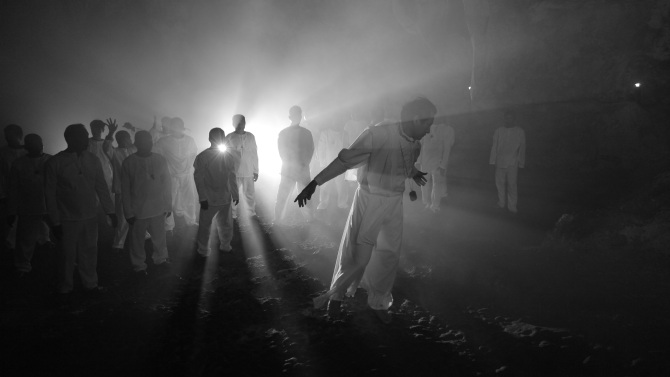
All stills are coming from Lav Diaz's movies : A Lullaby to the Sorrowful Mystery (2016) / Prologue to The Great Desaparecido (2013) / Prologue and Melancholia (2008) / Evolution of a Filipino Family (2004) and A Lullaby / A Lullaby / A Lullaby.
Salamat Hazel, John Lloyd, Kristine, Bianca and Alonso for support, insights and suggestions.
